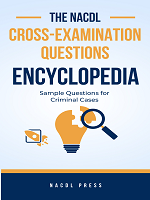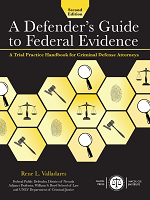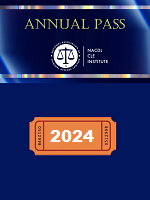Access to The Champion archive is one of many exclusive member benefits. It’s normally restricted to just NACDL members. However, this content, and others like it, is available to everyone in order to educate the public on why criminal justice reform is a necessity.
Publisher’s Note: This month, when the nation will inaugurate the 44th president of the United States, I want to share an extraordinary experience, not of something that happened “Inside NACDL,” but of something magical and powerful that happened outside NACDL. It is a memory of an inexplicable and spontaneous force that blossomed in the streets of our nation’s capital on the night of November 4, 2008 — the night America fulfilled a promise of its birth.
As so many of every political viewpoint and ideology noted, irrespective of whether they support the policies of Barack Obama, the fact of his election is a watershed in American history. It proved yet again the capacity of the United States to stun the world with its embrace of freedom and equality.
I watched the election returns in my apartment a couple of blocks from NACDL’s headquarters in downtown Washington, D.C. — about three blocks from the White House. I was joined by my wife Linda A. Reimer, an education administrator, and a dear friend, Louis Toscano, a journalist, political adviser and writer. The three of us were born just a few months apart in 1952 — the year Dwight Eisenhower was elected president. We share hazy memories of the late 50s, and came of age in the 60s — the period when the drive to end de jure segregation in America entered its final, decisive phase. — NLR
A Night to Remember
Approximately 11 p.m. in the East. All signs suggested that with the polls closing in the reliably blue western states, this would be the hour when the broadcast networks would feel confident to proclaim what their exit polling had suggested for hours — Barack Obama had been elected president of the United States. Sure enough, as one network after the other made the call, the news was official. As we awaited the president-elect’s remarks, it became increasingly difficult to hear because joyous screams of excitement, exuberant clapping, and the blare of car horns had broken out throughout the city.
We hold these truths to be self-evident, that all men are created equal . . .
Declaration of Independence,Adopted July 4, 1776.
After the new president-elect spoke, we ventured into the streets of the capital. It was like Mardi Gras, New Year’s Eve and a hometown sports championship all rolled into one. Hordes of people swarmed on the streets, waving from cars, cheering, smiling, embracing total strangers, honking horns, and many simply weeping with joy. Never saw anything like it. We had planned earlier in the day that if Senator Obama prevailed, we would visit the Lincoln Memorial, but on our way there it was impossible to bypass the irresistible human current flowing toward Pennsylvania Avenue and 16th Street. We let this cascading force of nature carry us along, wondering if the march to the seat of government was somehow a collective exhalation of relief that the burden of America’s false promise had finally been lifted.
Representatives and direct Taxes shall be apportioned among the several States which may be included within this Union, according to their respective Numbers, which shall be determined by adding to the whole Number of free persons, including those bound to Service for a Term of Years, and excluding Indians not taxed, and three fifths of all other Persons.
U. S. Constitution Article I, Section 2 [3].Note: Changed by Section Two of the Fourteenth Amendment in 1868.
There were thousands jamming Lafayette Park, spilling onto Pennsylvania Avenue, cheering alternatively, “yes we can” and “yes we did.” Looking south across the avenue, aglow in the nighttime spotlights, but eerily silent and detached on this oddly warm and dank evening, stood the symbol of American government — the White House. That silent detachment stood in stark contrast to the unrestrained merriment unfolding on its perimeter. Police and secret service maintained a presence along the fence outside the north portico, but there was no interference, no attempt to quell the celebration. Surely, many were reveling in the triumph of their candidate of choice, but more pervasive was the sense that this was something bigger than a mere political victory. My companions and I mused about what our president, isolated and securely stowed in that historic old mansion, must be thinking.
Many of our citizens thought they would never live to see this day. This moment is especially uplifting for a generation of Americans who witnessed the struggle for civil rights with their own eyes — and four decades later see a dream fulfilled.
President George W. Bush,November 5, 2008.
Then it was off to the Lincoln Memorial. It seemed like the right place to go for those who watched the August 28, 1963, March on Washington live on a little black and white television with rabbit ears. That indelible image of Martin Luther King Jr. gazing upon a sea of hope and determination gathered on the National Mall, framed by the stately image of the Lincoln Memorial, has reverberated in memory throughout the decades.
I have a dream that my four children will one day live in a nation where they will not be judged by the color of their skin but by the content of their character.
Martin Luther King Jr.,August 28, 1963.
But little did we know how quickly the hopeful optimism of that summer day would be snuffed out by many more chapters of violence and struggle. Just 18 days later, that same grainy television screen brought the image of Addie Mae Collins and three other young girls killed in a Birmingham church bombing. The next year there was the killing of Goodwin, Schwerner, and Chaney — two northern white kids and a southern black murdered for opposing segregation. And eventually, Dr. King himself was cut down before his dream could be realized. But not before the passage of the Civil Rights Act and Voting Rights Act — the legal swords that struck down segregation and cleared the path that would make possible the events of November 4, 2008.
As I cast my vote (for Barack Obama), I could hear Daddy’s words to the Congress about the Voting Rights Act … ringing in my ear, “Their cause must be our cause too. … It is really all of us who must overcome the crippling legacy of bigotry and injustice, and we shall overcome.”Luci Baines Johnson, quoting
her father, President Lyndon Baines
Johnson, November 24, 2008.
And so we approached the Memorial, mostly shrouded in shadow, but with a faint glow of dim light emanating from the inner sanctum. Paradoxically, most of the approach is encased in a chain link fence, as workers complete a renovation for a planned rededication in 2009 to coincide with the 200th anniversary of Abraham Lincoln’s birth. We gingerly ascended the long stone staircase, rendered slippery by the damp mist, pausing periodically to glance behind at the Mall’s reflecting pools. As we approached the sculpture of Lincoln, there was a palpable sense of completion. We joined other small contemplative groups — all ages, all races, some in complete silence, a few softly singing spiritual tunes. There was little conversation; no cheering or chanting here, not in this temple of freedom.
Gazing upward at the massive sculpture of Lincoln serenely looking out across the Mall, there was an inescapable sense that a moment that had been dreamed of for 400 years, since the first enslaved were brought to this continent, was upon us. The Founders had proclaimed a nation in which all are equal — even though they knew that was not the case. But they had sown seeds of hope. Seeds that might lie dormant for ages. Many probably hoped they would never germinate. Lincoln came on the scene when seedlings of equality were finally sprouting. Easily, he could have crushed them. But he chose instead, at unimaginable cost, to let them grow.
Whenever I hear any one arguing for slavery I feel a strong impulse to see it tried on him personally.
President Abraham Lincoln,
March 17, 1865.1
One hundred years later, as King said in 1963, America still had “defaulted on the promissory note” that was the Emancipation Proclamation. But with breathtaking eloquence, King stood on the steps of the Lincoln Memorial, gazing toward the dome of the U.S. Capitol, and imagined a distant day when that promise would at long last be fulfilled.
On the night of November 4th, that distant day had arrived.
Peering from the precise spot where King stood, we looked far across the Mall at the brilliant glow of the Capitol. We now knew that in 77 days, Barack Obama, an African American, a lawyer from Illinois, just like the 16th president, would look back toward his predecessor’s Memorial and take the oath of office as America’s 44th president.
If there is anyone who still doubts that America is a place where all things are possible, who still wonders if the dream of our founders is alive in our time, who still questions the power of our democracy, tonight is your answer.
President-elect Barack Obama,November 4, 2008.
Notes
- The Collected Works of Abraham Lincoln 361 (Roy P. Basler ed., Volume 8) Speech to One Hundred Fortieth Indiana Regiment (March 17, 1865).






